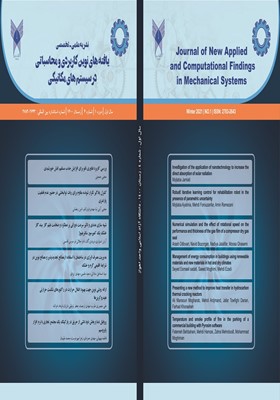مدیریت مصرف انرژی در ساختمان با استفاده ازمصالح تجدیدپذیر و مصالح نوین در شرایط اقلیم گرم و خشک
محورهای موضوعی : یافته های نوین کاربردی و محاسباتی در سیستم های مکانیکیسید اسماعیل ساداتی 1 * , سعید مقیمی 2 , مهدی ایزدی 3
1 - دانشگاه سمنان
2 - دانشگاه سمنان
3 - سمنان
کلید واژه: شرایط اقلیمی, بهینه سازی مصرف انرژی, دیزاین بیلدر, مصالح تجدیدپذیر,
چکیده مقاله :
صرفهجویی در مصرف انرژی یکی از چالشهای مهم جهان امروز میباشد. در سالهای اخیر افزایش نگرانیها در خصوص تبعات زیستمحیطی مصرف انرژی و گرم شدن کره زمین اهمیت این موضوع را دوچندان کرده است. از سوی دیگر سهم بخش ساختمان در مصرف انرژی کشورها قابلتوجه است و به همین دلیل، در چند دهه اخیر، در اکثر کشورهای صنعتی، اقدامات اساسی درزمینه اصلاح الگوی مصرف، با استفاده از ابزارهای مختلف ازجمله تدوین مقررات و ضوابط، صورت گرفته است. یکی از مهمترین انرژیهای مصرفی، انرژی الکتریکی می باشد که از اساسیترین منابع انرژی ساختمان ها بوده و نقش مهمی را ایفا میکند. مشکلات و فرایندهای پیچیده تولید و انتقال انرژی الکتریکی، آلودگیهای حاصل از تولید آنکه از سوختن سوختهای فسیلی حاصل میگردد و موارد دیگر محققان را بر آن داشته تا به دنبال راه چاره بهمنظور کاهش مصرف انرژی یا به عبارتی بهینهسازی مصرف انرژی باشند. در این تحقیق برخی از راهکارهای عملی برای حرکت به سمت صرفهجویی انرژی بررسی گردیده و تأثیر استفاده از مصالح با ضریب انتقال حرارت مختلف در دیوارهای خارجی با توجه به شرایط آب و هوایی سمنان بر روی ساختمان مدلسازی شده بررسی و به تحلیل بار سرمایش و گرمایش ساختمان در مقایسه با مصالح تجدید پذیر پرداخته گردید. درنهایت دیوار خارجی با استفاده از بلوک کاهگلی 20 سانتیمتری، منجر به کاهش مصرف انرژی سالیانه نسبت به سفال سوراخ دار، بتن اتوکلاو شده و مبحث 19 مقررات ملی به ترتیب به میزان 3%، 0.6%، 2.76% شده است.
Saving energy is one of the most important challenges in the world today. In recent years, growing concerns about the environmental consequences of energy consumption and global warming have doubled in importance. On the other hand, the share of the construction sector in the energy consumption of countries is significant and for this reason, in recent decades, in most industrialized countries, basic measures have been taken to improve consumption patterns, using various tools such as regulations. One of the most important energy consumed is electrical energy, which is one of the most basic energy sources of buildings and plays an important role. The complex problems and processes of electricity generation and transmission, the pollution generated by the production of fossil fuels, and other cases have prompted researchers to seek solutions to reduce energy consumption or, in other words, optimize energy consumption. In this study, some practical solutions to move towards energy saving have been investigated and the effect of using materials with different heat transfer coefficients in external walls according to Semnan weather conditions on the modeled building and to analyze the cooling and heating load of the building. Compared with renewable materials. Finally, the external wall, using a 20 cm straw block, has reduced the annual energy consumption compared to perforated pottery, autoclaved concrete, and Article 19 of the National Regulations has resulted in 3%, 0.6%, and 2.76%, respectively.
_||_
[1] Heydari, A., Sadati, s., Gharib, m., (2021), Effects of different window configurations on energy consumption in building: Optimization and economic analysis, Journal of Building Engineering, 35:102099.
[2] Stephan, A., Robert, Crawford., Kristel, M., (2011), Towards a more holistic approach to reducing the energy demand of dwellings, Procedia Engineering, 21, pp 1033-41.
[3] Capros, P., Mantzos, L., Papandreou, V., Tasios, N., (2008), European energy transport trends to 2030 – update 2007, in: Directorate-General for Energy and Transport, European Commission Brussels, April, pp 156-178.
[4] Andarini, A., Rahmi, R., (2014), The Role of Building Thermal Simulation for Energy Efficient Building Design, Energy Procedia, 47, pp 217-26.
[5] Hichem, N., Settou, N., Saifi, N., Damene, D., (2013), Experimental and Numerical Study of a Usual Brick Filled with PCM to Improve the Thermal Inertia of Buildings, Energy Procedia, 36, pp 66-75.
[6] Dabaieh, M., Omar, W., Hegazy, H., Erik, Johansson., (2015), Reducing cooling demands in a hot dry climate: A simulation study for non-insulated passive cool roof thermal performance in residential buildings, Energy and Buildings, 89, pp 142-152.
[7] Radhi, H., (2011), Viability of autoclaved aerated concrete walls for the residential sector in the United Arab Emirates, Energy and Buildings, 43, pp 86-92.
[8] Anastaselos, D., Oxizidis, S., Papadopoulos, A., (2011), Energy, environmental, and
economic optimization of thermal insulation solutions by means of an integrated decision support system, Energy and Buildings, 43,pp 686–694.
[9] Griego, D., Krarti, M., Hernández, A., (2012), Optimization of energy efficiency and thermal comfort measures for residential buildings in Salamanca Mexico, Energy and Building, 54, pp 540–549.
[10] سید اسماعیل ساداتی و همکاران، (1400)، تاثیر مقدار ضرایب هدایت حرارتی مصالح ساختمانی طبق مراجع مختلف در بار حرارتی و انتشار گاز دی اکسید کربن ساختمان، مجله مهندسی مکانیک و ارتعاشات
[11] سید اسماعیل ساداتی و نادر رهبر،(1396)، بررسی تاثیر استفاده از مصالح مختلف ساختمانی بر میزان مصرف انرژی یک ساختمان نمونه با نرم افزار دیزاین بیلدردر شرایط اقلیم سمنان،سومین کنفرانس انتقال حرارت و جرم ایران
[12] مبحث نوزدهم مقررات ملّی ساختمان، (1389)، صرفه جویی درمصرف انرژی، دفتر امور مقررات ملّی ساختمان
[13] Giroudon, M., Laborel, A., Jean-Emmanuel, A., Magniont, C., (2019), Comparison of barley and lavender straws as bioaggregates in earth bricks, Journal of Construction and Building Materials, 202, pp 254–265.
[14] Software, Design Builder, Document help, In The US Department of Energy.
[15] Software, Energyplus, (2011), Energyplus Engineering Document help, In: The US Department of Energy.
[16] Stephan, A., Robert, H., Kristel, Myttenaere., (2011), Towards a more holistic approach to reducing the energy demand of dwellings, Procedia Engineering, 21, pp 33-41.

